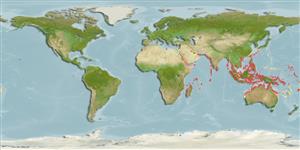Common names from other countries
>
Eupercaria/misc (Various families in series Eupercaria) >
Scaridae (Parrotfishes) > Scarinae
Etymology: Scarus: Greek, skaros = a fish described by anciente writers as a parrot fish; 1601 (Ref. 45335).
More on author: Smith.
Environment: milieu / climate zone / depth range / distribution range
Ecologia
marinhas associadas(os) a recifes; não migratória; intervalo de profundidade 1 - 15 m (Ref. 90102). Tropical
Western Indian Ocean: East Africa, including Madagascar, Seychelles, and Maldives. Also reported from Phuket, Thailand and Bali and Sulawesi, Indonesia (Ref. 9232). Probably related to Scarus spinus in the Central and Western Pacific.
Tamanho / Peso / Idade
Maturity: Lm ? range ? - ? cm
Max length : 45.0 cm TL macho/indeterminado; (Ref. 48636); peso máx. publicado: 600.00 g (Ref. 3488)
Descrição suscinta
Chaves de identificação | Morfologia | Morfometria
Males recognized by the nearly all green snout from front of eyes (Ref. 48636). 4 median predorsal scales; 2 scales on third row on the cheek; ii 12 pectoral fin rays; 1 main and 2 rudimentary rows of teeth on the upper pharyngeal which are deep interdigitated, with main teeth notched-shaped; length/width ratio of the lower dental plate is 2.80 (Ref. 37269).
Found solitary (Ref. 90102) in shallow reefs, on flats and reef fronts or rocky shores of high islands (Ref. 9710); also on mixed algae rubble and rich coral patches (Ref. 48636). Feeds on benthic algae (Ref. 30573). Caught with nets and other kinds of artisanal gear. Sold mostly fresh in markets (Ref. 3488). Close relative of S. spinus of the Pacific but has allopatric distribution (except Bali) (Ref. 90102).
Ciclo de vida ou comportamento de acasalamento
Maturities | Reprodução | Spawnings | Egg(s) | Fecundities | Larvas
Oviparous, distinct pairing during breeding (Ref. 205).
Bruce, R.W. and J.E. Randall, 1984. Scaridae. In W. Fischer and G. Bianchi (eds.) FAO species identification sheets for fishery purposes. (Western Indian Ocean fishing area 51). volume 3. [var. pag.] FAO, Rome. (Ref. 3488)
Status na Lista Vermelha da UICN (Ref. 130435)
CITES (Ref. 128078)
Not Evaluated
Ameaça para os humanos
Harmless
Uso pelos humanos
Pescarias: espécies comerciais
Ferramentas
Relatórios especiais
Baixar XML
Fontes da internet
Estimates based on models
Preferred temperature (Ref.
115969): 26.4 - 29.3, mean 28.6 (based on 2913 cells).
Índice de diversidade filogenética (Ref.
82804): PD
50 = 0.5000 [Uniqueness, from 0.5 = low to 2.0 = high].
Bayesian length-weight: a=0.01445 (0.00686 - 0.03044), b=3.03 (2.86 - 3.20), in cm Total Length, based on LWR estimates for this Genus-body shape (Ref.
93245).
Nível Trófico (Ref.
69278): 2.0 ±0.00 se; based on food items.
Resiliência (Ref.
120179): médio(a), tempo mínimo de duplicação da população 1,4 - 4,4 anos (Preliminary K or Fecundity.).
Fishing Vulnerability (Ref.
59153): Low to moderate vulnerability (35 of 100).
